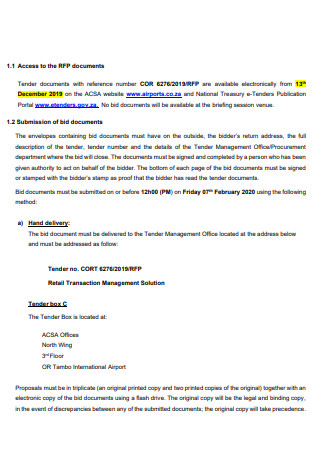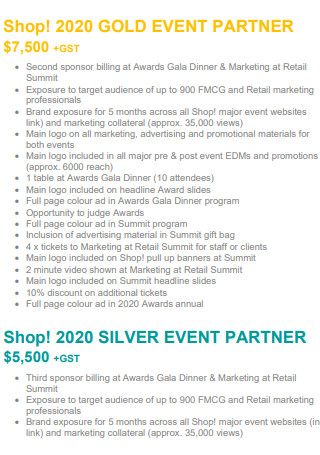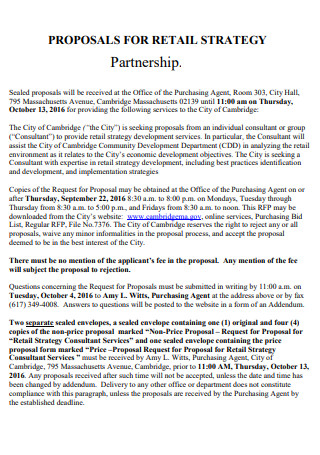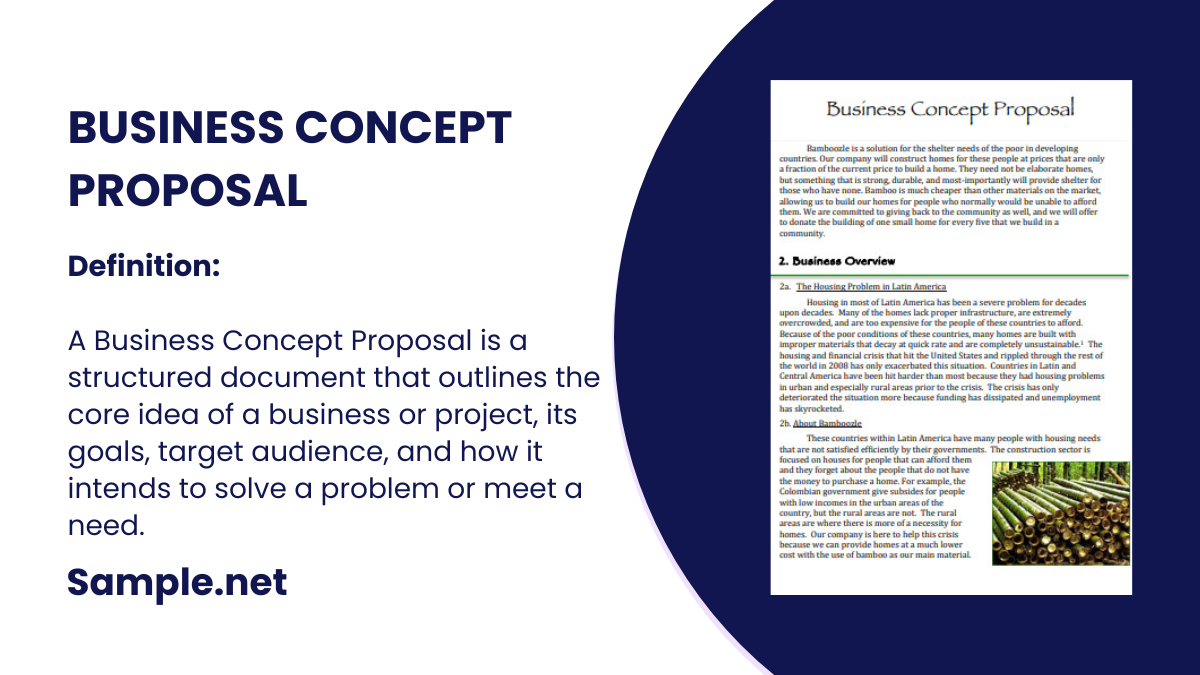A Business Concept Proposal is a structured document that outlines the core idea of a business or project, its goals, target audience, and how it intends to solve a…
continue reading
3+ SAMPLE Retail Partnership Proposal
What Is a Retail Partnership Proposal?
A Retail partnership proposal is a letter made when one company seeks to form a partnership with another. Creating a joint venture allows companies to develop and grow into new regions, lower manufacturing costs, and explore new markets to extend their consumer base. This proposal demonstrates your interests to the potential partner why you want to do business with them It explains who the business will benefit from and how it will assist them. It also gives the businessperson seeking the collaboration a chance to sell their company and showcase their short and long-term objectives. Feel free to check out the available proposal sample provided.
Reminder before Writing a Retail Partnership Proposal
Before you proceed to view the Retail partnership agreement sample and draft your proposal, keep these reminders in mind so that your process of creating a proposal will be smooth and without any hassle. The items listed below will surely help you to have an organized method in creating your retail partnership proposal.
Types of Retail Partnerships
Various retail partnership examples can help you visualize better the type of retail partnership that would fit well with your company and your chosen retail company. Go through the curated list so that you can see which type is most suitable and beneficial for your business as well as which is preferable for your retail partner.
Dos and Don’ts of a Retail Partnership Proposal
To develop an effective Partnership Proposal, you must cover a number of typical issues, such as the advantages, values alignment, and aims of such a collaboration, as well as how to organize any eventual abolishment of the partnership. In making sure you get off on the right foot, here are a few things to keep in mind when approaching a potential partner about forming a retail partnership. View the available agreement sample to see more of the format.
How to Write a Retail Partnership Proposal
A strategic relationship may propel your company forward and open new possibilities. You may use another company’s knowledge and resources to build your brand and reach more clients, regardless of your sector. It’s a win-win situation for all sides, and all it takes is a compelling proposition for collaboration. Think of this guide as a means for you to have a partnership proposal presentation constructed in an organized and neat manner. Most likely your proposed retail partner will be busy so you should avoid wasting their time. Take a look at the available partnership sample to get a better idea of how it is structured.
-
Step 1: Your Title Page Is Important
The precise formulation of your title page is the first step in crafting your partnership proposal. Take the time to ensure it is well-designed, informative, and free of proofreading or formatting issues, as this will be the very first impression your potential partners will have of your business. The title page will need to include the Title of your recommended project, your complete name and work title as a company representative, as well as legal business details. This will act as a captivating hook to get your readers or proposed retail partner to read more.
-
Step 2: Draft Out the Proposal
It is critical to clarify that your proposal must be supported by verifiable facts, collaboration advantages, and the project’s long-term consequences on your company. To guarantee that your reader gets the specific points for your offer, carefully explain it and state it without bias. This may be done quickly with bulleted points, bolded characters, and other text–editing tactics to make the project easier to scan and read. External connections to any Data, research, or case study that supports your assertions and works in your favor in persuading the reader to accept your offer should also be considered.
-
Step 3: Create a Milestone Centric Partnership Timetable
It is recommended that you establish a realistic partnership Timeline to accompany your partnership proposal in order to make it as comprehensible and attractive as possible. In terms of your retail collaboration, a basic left-to-right chronology of events might work wonders in your favor. To push your argument forward, you should develop easy milestones between the start of your relationship and the ultimate product of your cooperation. Keep in mind that the milestones you design should support the partnership’s ultimate aim and provide the reader a clear picture of how the process will function, what you need from them, and what they may anticipate from the partnership.
-
Step 4: Include a Complimentary Cover Letter
Even if you provide all of the technical facts of the proposed collaboration in your partnership proposal, it may not be enough to satisfy your reader or explain its merits. You can, however, explain your objectives with a complementing cover letter, similar to those produced for job applications. It’s important to note that your cover letter should be written by you or one of your assigned employees in a personal yet professional tone of voice.
-
Step 5: Summarize Your Proposal
You may create a separate page after your document to summarize your complete partnership proposal. Simply state what your idea contains, the advantages it would offer to both sides, and how it might impact your sector in the future in two to three paragraphs. Remember that your reader may utilize your summary to swiftly deliver the proposal to their coworkers and business partners without having to go through minute details in a short period of time. Include a thank you letter and a call to action for your reader to contact you as soon as possible at the end of the proposal.
FAQs
What is a retail partner’s role?
Retail Partner means a retailer, if any, who, via a separate arrangement with a client, provides incentives, prizes, products, or services available in conjunction with the card program, as envisioned by the implementation plan or otherwise approved by the parties. When done correctly, retail partnerships may result in more visibility and money, as well as happier consumers and sales for both sides.
What is the disadvantage of a retail partnership?
Unfortunately, not all retail collaborations are created equal. Collaboration with another brand comes with the same issues that may make personal partnerships difficult: differing goals, Visions, or values, untrustworthy partners, and so on. Since they are controlled by individuals, brands are analogous to people. Sometimes you will locate the ideal brand to collaborate with only to discover that you have substantial creative differences that you can’t seem to resolve. Working with people is difficult labor, and it’s a skill that must be developed and practiced.
What is the process of forming a retail partnership?
When two businesses genuinely care about one other, they sign documents, execute advertising campaigns, create goods, and work together to raise brand recognition. Two brands that have complementary but non-competitive audience bases, form retail partnerships. That implies their target audiences have some overlap, but they aren’t in direct competition with one another. This indicates that these brands would benefit from collaborating such as forming a retail relationship. In short, the options are virtually limitless, limited only by the collective inventiveness of the community.
No rules are stopping you from presenting your proposal using a partnership agreement template. Especially if you have never written a proposal before, you will find it useful. However, don’t forget the disadvantages of using a generic proposal. It’s not enough to just express your thoughts and ideas to a potential partner; you also need to know how to target your audience by telling them what they want to hear. While you don’t want to reveal too much, the proposal should be clear and compelling enough to persuade someone to trust you and your company’s ideas.





![25+ SAMPLE Marketing Budgets [ Business, Plan, Digital ] marketing budgets](https://images.sample.net/wp-content/uploads/2021/02/Marketing-Budgets.jpg)